Table of contents
- On the move: BMW R 75/5, Honda CB 750 The summer of 69
- The BMW R 75/5 takes the stage
- Color and form language from two epochs
- Driving impressions
- Technical specifications
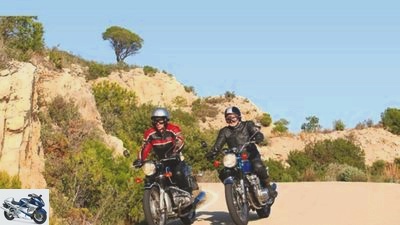
wolf
motorcycles
On the move: BMW R 75/5, Honda CB 750
On the move: BMW R 75/5, Honda CB 750
The summer of 69
Content of
Bryan Adams musically summed up the exhilaration that was widespread at the end of the 1960s. A spirit of optimism was also clearly noticeable among the motorcyclists.
Waldemar Schwarz
02/06/2009
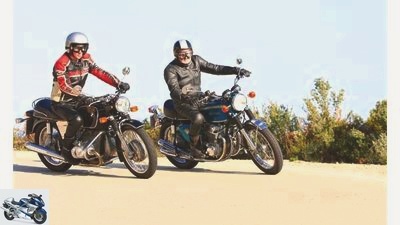
wolf
One year of birth, but two eras: BMW R 75/5 and Honda CB 750.
Not only in Germany did young people take to the streets in 1968 and question all conventions. The zeitgeist favored Rudi Dutschke, the extra-parliamentary opposition, free love and the rejection of everything that showed even a hint of the traditional. Traditional keepers and conservative forces had to look like philistines, as “Establishment” let insults. The clocks stood in protest, what provoked the said philistines was legitimate: “If you sleep with the same person twice, you already belong to the establishment.” In the USA, the young generation took to the barricades against the Vietnam War: “Make love was not” was their motto. The new attitude towards life manifested itself in the flower power movement and the legendary Woodstock Festival.
And the motorcycle world? It seemed pretty stuck. The top models from England persisted in bumper-controlled two-cylinder lethargy, the Italians practiced southern improvisation with a wide variety of models, and the German motorcycle industry ended its slumber only to then fall seamlessly into a coma: The top products, the two-cylinder boxers from BMW, were almost unchanged since 1956, the R 69 S on the market since 1960. The company even considered completely stopping motorcycle production. The Japanese alone showed with ever new achievements where the road could lead: Rotary vane-controlled two-cylinder two-stroke engines from Kawasaki and the Honda CB 450 with two overhead camshafts demonstrated what is technically feasible.
In 1969 events came tumbling down: as early as 1968, Erlkonig pictures of a large four-cylinder Honda appeared. The 5/1969 issue of Das MOTORRAD presented the final version with a bang. No motorcyclist, whether sympathizer or opponent of the Japanese faction, could get past the technical finesse of the Four. In-line four-cylinder engines were not a novelty in motorcycle construction, even transversely installed: The exotic MV Agusta 600 and the highly exclusive Munch had such an engine, but these pieces were beyond the financial reach of a motorcyclist with a normal income. The CB 750 is different: 6500 marks was a lot of money, but for many enthusiasts it was in the realm of possibility, which brought the Honda CB 750 a lot of pre-orders long before the start of series production.
She stood there in bright metallic colors, displaying her elegant inline four-cylinder with overhead camshaft, dry sump lubrication and five-speed gearbox. She cocked her four megaphone-shaped exhausts to the rear to show the overtaken where the hammer hangs. It made 67 hp from a displacement of 736 cc, and was clearly at the forefront of sporty motorcycles up to 750 cc. In one fell swoop, it offered significantly more power than the top models from all other manufacturers. A hydraulically operated disc brake in the front wheel had never existed before in series production of motorcycles; The 600 MV had two disc brakes, but the driver operated them mechanically with a cable.
Just one issue later, Das MOTORRAD presented the next hammer from Japan: the Kawasaki 500 Mach III H1. The three-cylinder machine with 500 cc and 60 hp outclassed the two-stroke competition by far and, with its potential and its power delivery, was not far from thoroughbred 500 cc racing machines. In the same issue, the editors of Das MOTORRAD announced a 650cc four-cylinder from
Yamaha, but in this case they fell for a duck.
Another bang in issue 7: the English partners Triumph and BSA each put a similar three-cylinder four-stroke engine with 750 cm³ at the top of their model range. A brave step and a riot for the British motorcycle industry, even if the ohv triplets could not quite keep up with the Honda in terms of performance, at least nominally.
The BMW R 75/5 takes the stage
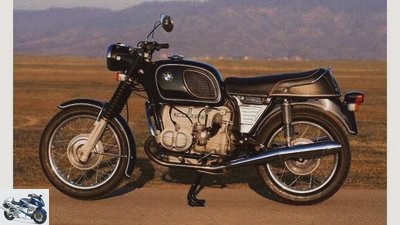
wolf
In 1969 BMW turned the boxer world upside down with the R 75/5.
The answer came from Munich in the fall. BMW presented its new boxer series in Das MOTORRAD 18/1969. Compared to the previous models, no stone was left unturned, even if the engines were very similar. Sports fans’ silent hopes for an ohc boxer were not fulfilled: in the new R 50, R 60 and R 75/5 models, too, a central camshaft, now located below the crankshaft, operated the valves via bumpers and rocker arms; the crankshaft was completely slide bearing. With 50 hp, however, the top model did not come close to the performance of the Honda.
The chassis was also completely new: a double loop frame took up the boxer, and a telescopic fork, which had already upgraded the US versions of the previous models, guided the front wheel. Concerned, of course – keyword “Establishment” – a cardan the final drive.
But that did not end the round of new presentations. In fact, Yamaha presented a 650, but not with four, but only with two cylinders. The optical borrowings in England and the modern technology with an overhead camshaft should appeal more to conventional motorcyclists. Shortly before the end of the year, MV Agusta landed the last bang of the season at the Milan trade fair with the sensational 750 S: Its engine with two overhead camshafts showed a strong relationship to the former Grand Prix racing machines, but the cardan drive did not really fit. In addition, it would only find its way to well-heeled customers years later.
The Honda fans had better luck: They were able to receive the first motorcycles at the end of the year. Previously had serious “glob” Leverkus has already published a driving report and a test. After his first contact with a pre-production motorcycle in the winter of spring on partly snow-covered roads, his impression was: “Driving is something new. The areas in which you move on this motorcycle are several degrees higher than anything else you move on two wheels.”
However, before the first thorough test, he expressed doubts: “We asked ourselves what the 67 hp would do with the Honda.” The all-clear followed immediately: “It is a very, very fast machine that is very easy to hold in your hand and that in some cases does not even let you notice the high speed.”
Obviously, he quickly gained confidence in the chassis and brakes: “Where would the lap times on the ring come from if this framework weren’t up to the performance? There are no serpentines at high speed. We have to confirm that the driving performance was influenced to a great extent by the fact that one went very far
can approach the curves and then brake the machine down.”
His conclusion was ultimately positive and benevolent, if not overly euphoric: “Due to the running characteristics of the engine, the gear ratio, the brakes and the handiness, the CB 750 is a cultivated motorcycle in which the designers invest new thoughts and details.”
Color and form language from two epochs
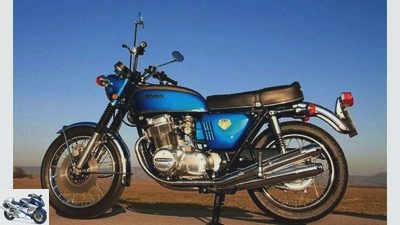
wolf
Two weeks later there was a test with the new BMW R 75/5, and it seemed to impress a lot – less in terms of top performance, but more in terms of power delivery and chassis: “The reason for high average speeds lies in an excellent chassis, in the surprising handiness and in the performance characteristics of the engine. The chassis is definitely faster than the engine, more power would be manageable.”
The obligatory test course almost made the otherwise sober Leverkus express emotions: “The laps around the Nurburgring have shown us as seldom that a successful chassis can more than replace a lot of engine power in a failed chassis.” With his driving impressions, Klacks had made motorcyclists hot and predicted for 1970: “Guys, it’s gonna be a year!” In a comparative test, however, the Honda CB 750 and the BMW R 75/5 never competed directly against each other in Das MOTORRAD.
Today, 40 years later, a Honda CB 750 and a BMW R 75/5 shine and sparkle in the Spanish winter sun and are ready for the showdown. The BMW from specialist Hans-Joachim Siebenrock corresponds to a later model year – it already has the chassis with the extended swing arm – and connoisseurs will recognize the typical features of the subsequently installed five-speed transmission. But for a comparative impression that only plays a subordinate role.
The Honda CB 750 from collector Jurgen Hoch is brand new; No wonder, after all, it is an original model from the first hour with a mileage of 125. It is not only a representative of the so-called K0 series, but also the very first version with a sand-cast housing, which is highly coveted among collectors. The only deviations from the series are the current BT-45 tires from Bridgestone – essential to get this valuable item safely through the ends.
The visual impression of two direct competitors could hardly be more different: The chrome-plated fenders, the exhaust system and the polished engine housing cover of the Honda with their turquoise candy metallic paintwork sparkle in contrast. The R 75 stands next to it in penitential garb, black on black. After all, BMW also supplied other paintwork for the / 5 series for the first time, for example the popular silver with blue trim.
The seat test also reveals major differences: On the Honda, the driver sits upright, arms spread out behind the sweeping US handlebars, and only the legs are almost sportily angled. The BMW feels completely different: The sporty, narrow handlebars force the pilot into a slightly bent position, but the knees are only moderately bent.
After the fitting, it goes on narrow, mountainous coastal roads. Here the two opponents reveal their very different philosophies. The BMW boxer shines with a powerful acceleration from low engine speeds, which lasts up to around 5500 rpm. Turning higher is of little use, the engine then works hard and shows its displeasure with stronger vibrations. Tearing open the throttle flaps of the Bing constant pressure carburettor from tight corners is what the BMW acknowledges without swallowing problems and with a lot of thrust at all times. The sonorous hum, moderate in volume, has an almost calming effect. When changing gears, the transmission demands time and a sustained step on the gearshift lever; it always accompanies the process acoustically. The five-speed gearbox installed in our example certainly has advantages in certain situations, but thanks to the engine characteristics of the BMW, it does not prove to be absolutely necessary.
The chassis supports the easy handling of the boxer: The Bavarian can be turned playfully over the narrow handlebars and almost automatically falls into bends. Both the lower weight compared to the Honda – 210 to 235 kilograms – and the arrangement of the engine with the longitudinal crankshaft give the BMW clear advantages in terms of maneuverability. But where there is light, there is also shadow: the position of the motor generates a rolling movement around the longitudinal axis with every load change. The easy-care cardan also has to pay tribute to driving operations. A typical side effect is the pronounced elevator effect – every time the gas is applied, the rear noticeably lifts out of its springs. Both peculiarities quickly become routine, the real BMW driver no longer notices them after a very short time, at best registers the extremely comfortable suspension setting of the long-stroke telescopic fork and the Boge struts.
The brakes require a lot of manual force for proper deceleration; the double-cam drum in the front wheel looks a bit doughy. Nevertheless, the BMW offers a lot of fun on winding roads thanks to the engine characteristics and the handy chassis. The Honda can also have fun, albeit in a different form: the four-cylinder looks more powerless, rather strenuous, in the lower speed range, although it also reacts to the opening of the four throttle slides in the Keihins without the slightest swallowing. It demands speeds in order to release decent power: If the needle exceeds the 4000 mark, the four-wheeler inspires with its rotational ability and continuously increases in power. The engine accompanies higher regions with a hoarse, rattling soundscape from the 4-in-4 exhaust system, only accompanied by a fine, barely noticeable tingling in the handlebars in the highest regions.
Driving impressions
On the winding Spanish regional roads, the Honda increasingly demands a step on the gearshift lever, but it is always a pleasure: with little force, the gears engage silky smoothly. The chassis, on the other hand, requires more effort when turning into tight bends. Despite the wide handlebars, the Honda does not fall into tight bends as easily as the BMW, but offers great advantages when anchoring. Although the swivel caliper of the front disc brake also requires sustained manual force for today’s conditions, it then decelerates far more effectively than the drum brake of the BMW and is easier to dose.
In terms of comfort, the Honda cannot keep up with the BMW. The fork of the CB 750 absorbs bumps sensitively, but the suspension struts do not filter out unevenness as cleanly as those of the BMW and appear slightly underdamped. While the Honda cannot make decisive use of its clear superiority in performance on tight courses, the tide turns on Spanish national roads and motorways. At higher speeds, for example when overtaking, the Honda effortlessly exploits its extra horsepower: Briefly downshift, let the engine cheer, and the CB 750 is still a fast motorcycle today.
The BMW has a hard time following the CB, although the sitting position behind the narrow handlebars is more comfortable in this case than behind the wide sail pole of the Honda. The Japanese chassis also shows its positive side on expressways. It is not just because of the current tires that the Honda pulls its course smoothly in fast bends even on bumps and belies the stressed tale of life-threatening Japanese commuting.
Because of the comfortable suspension setup and the characteristics of the longitudinal crankshaft and the cardan shaft, the BMW struggles more with its own movements, which sometimes disrupt the clean line. In the practical chapter, on the other hand, the Bayern boxer has the edge: It’s not just the cardan drive that ensures ease of maintenance in everyday life. The manually adjustable spring base of the spring struts for the changeover to two-man operation and the excellent tools also offer perfect handling in the worst-case scenario.
A lot of intense impressions remain after a long day. On the one hand, that Honda has put together a great package with the CB 750. Today it still exudes a fascination that neither uninvolved pedestrians nor drivers of modern motorcycles can simply escape.
The BMW, which is visually understated, attracts the attention of the environment far less, but still offers a lot of driving fun and in a direct comparison is not as far behind the Honda as the pure numbers suggest. Both opponents stand for the spirit of optimism in 1969. It triggered a revolution in the motorcycle world that spurred the competition to new achievements and thus advanced two-wheeler development to this day. Perhaps the early 1970s weren’t for every motorcyclist “The best days of my life”, as Bryan Adams claims it for himself, but certainly the start of a very exciting era.
Technical specifications
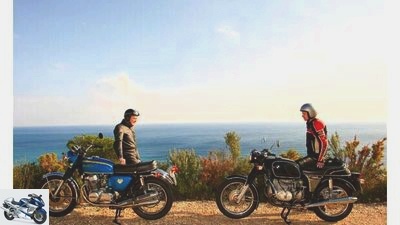
wolf
The BMW R 75/5 called the BMW R 75/5 10 cm³ more and 17 hp less. The differences to the Honda CB 750 are bigger than numbers can express.
BMW R 75/5
engine: air-cooled two-cylinder four-stroke boxer engine, a central camshaft, two valves per cylinder, bumpers, rocker arms; Bore 82 mm, stroke 70.6 mm, displacement 746 cm³,
Compression 9.0: 1, 50 HP at 6200 rpm, two Bing equal pressure carburetors, Ø 32 mm
Electrical system: Electric and kick starter, battery 12 V / 15 Ah, contact-controlled battery ignition, three-phase alternator, 180 W.,
Power transmission: Single-disc dry clutch, four-speed gearbox, primary drive: none, secondary drive: cardan,
Landing gear: Double loop frame made of tubular steel, front telescopic fork, rear swing arm, two spring struts, wire-spoke wheels with aluminum rims, front tires 3.25 – 19, rear tires 4.00 – 18, front duplex drum brake, Ø 200 mm, rear simplex drum brake, Ø 200 mm
Measurements and weight: Weight 210 kg, tank capacity 24 liters
Driving performance: Top speed 175 km / h
Price: 4996 Mark (1969)
Manufacturer: BMW AG, Munich, Germany
Honda CB 750
engine: air-cooled four-cylinder four-stroke in-line engine, one overhead camshaft, two valves per cylinder, rocker arm; Bore 61 mm, stroke 63 mm, displacement 736 cm³, compression 9.0: 1, 67 hp at 8000 rpm, four Keihin round slide carburettors, Ø 28 mm
Electrical system: Electric and kick starter, battery: 12 V / 14 Ah, contact-controlled battery ignition, three-phase alternator, 210 W.
Power transmission: Multi-disc oil bath clutch, claw-shift five-speed gearbox, primary drive: two chains, secondary drive: chain
Landing gear: Double loop frame made of tubular steel, front telescopic fork, rear swing arm, two spring struts, wire-spoke wheels with steel rims, front tires: 3.25 – 19, rear tires: 4.00 – 18, front disc brake, Ø 260 mm, single-piston swivel caliper, rear simplex drum brake, Ø 180 mm
Measurements and weight: Weight 235 kg, tank capacity 18 liters
Driving performance: Top speed 200 km / h
Price: 6495 Mark (1969)
Manufacturer: Honda Motor Co. Ltd, Tokyo, Japan
Related articles
-
Honda CBR 300 R and Honda CBR 500 R in comparison test
Gargolov 33 pictures Rossen Gargolov 1/33 Two against one is not fair? We see how the single-cylinder Honda CBR 300 R fares against the two-cylinder…
-
Sdun counselor Used purchase Used advice Honda Deauville Used advice Honda Deauville Full dresser light The sophisticated concept of the mid-range model…
-
Honda NC 700 S in the test: the entry-level motorcycle from Honda
Artist 12th pictures Honda 1/12 Honda NC 700 S – The naked bike is powered by an in-line two-cylinder engine of 670 cubic meters. Honda 2/12 Honda NC 700…
-
Comparison test: Honda Hornet, Kawasaki Z 750, Suzuki GSR 600
Jahn motorcycles Comparison test: Honda Hornet, Kawasaki Z 750, Suzuki GSR 600 Comparison test: Honda Hornet, Kawasaki Z 750, Suzuki GSR 600 ABS shooters…
-
fact motorcycles Comparison test: Honda CBR 600 RR, Kawasaki ZX-6R, Suzuki GSX-R 600, Triumph Daytona 675, Yamaha YZF-R6 Comparison test: Honda CBR 600…
-
Honda counselor Used purchase Used advice Honda CBF 500 Used advice Honda CBF 500 More than a driving school bike In the ranking of the most…
-
Bilski counselor Used purchase Used advice Honda CBR 1100 XX Second hand advice Honda CBR 1100 XX (2001) Eco solution? The CBR 1100 XX started in 1996 as…
-
New models: Honda CB 1100 2013
Honda motorcycles New models: Honda CB 1100 2013 New models: Honda Honda CB 1100 2013 Since the presentation of the CB 1100 design study at the Tokyo…
-
counselor Used purchase Used advice Honda CB 500 Used advice Honda CB 500 From the same mould Honda’s new model in the inexpensive entry-level class had…
-
Bilski motorcycles Naked bike Top test Honda Hornet 600 Top test Honda Hornet 600 Salute Europe’s top seller 2002. Unfortunately only 25th in Germany. So…